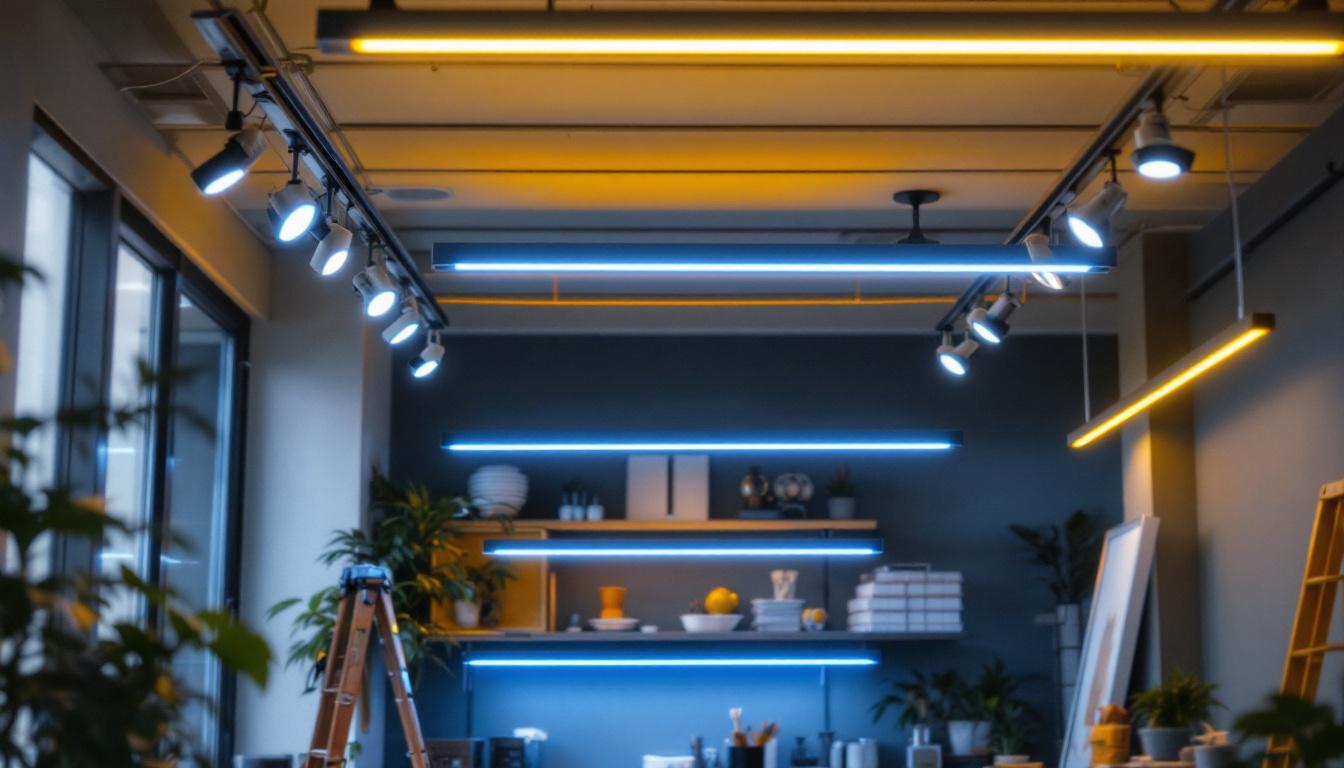
Flood solar lights have become an increasingly popular choice for outdoor lighting solutions, particularly among lighting contractors aiming to deliver sustainable, cost-effective, and high-performance installations. These lights harness solar energy, converting sunlight into electrical power to illuminate large areas such as building facades, parking lots, gardens, and pathways. However, maximizing their efficiency requires a thorough understanding of their components, operational principles, and environmental factors.
At the core, flood solar lights consist of photovoltaic (PV) panels, rechargeable batteries, LED bulbs, and control circuitry. The PV panels capture sunlight and convert it into electrical energy, which is stored in batteries for use during nighttime. LEDs are favored for their low power consumption and high luminous efficacy, making them ideal for solar applications. Control systems, including sensors and timers, regulate the light output to optimize energy usage.
For lighting contractors, recognizing how each component interacts and influences overall performance is essential. This foundational knowledge enables informed decisions regarding product selection, placement, and configuration to achieve maximum lighting efficiency and client satisfaction.
Additionally, the geographical location and seasonal variations play a significant role in the performance of flood solar lights. Areas with abundant sunlight will naturally enhance the efficiency of these systems, allowing for longer operational hours during the night. Conversely, regions that experience extended periods of cloud cover or shorter daylight hours may necessitate the use of higher-capacity batteries or more efficient PV panels to ensure reliable performance. Understanding these environmental factors can guide contractors in tailoring their installations to meet the specific needs of different locations, ultimately leading to a more effective lighting solution.
Moreover, advancements in solar technology have led to the development of smart flood solar lights, which incorporate features such as motion sensors and remote control capabilities. These innovations not only improve energy efficiency by ensuring lights are only activated when needed but also enhance security in outdoor spaces. As smart technology continues to evolve, lighting contractors must stay informed about the latest trends and features to provide clients with cutting-edge solutions that are both practical and environmentally friendly.
The efficiency of the solar panel directly impacts the amount of energy harvested during daylight hours. Monocrystalline panels typically offer higher efficiency rates compared to polycrystalline counterparts, often exceeding 20% conversion efficiency. While they may come at a higher initial cost, their superior performance can justify the investment, especially in installations where space is limited or sunlight exposure is variable.
Durability is equally important. Panels should be rated for outdoor use, with robust construction to withstand weather extremes, including heavy rain, wind, and temperature fluctuations. Look for panels with tempered glass and corrosion-resistant frames to ensure longevity and consistent performance over time.
The rechargeable battery stores the energy collected by the solar panel and powers the LED floodlight after sunset. Lithium-ion batteries have become the preferred choice due to their high energy density, longer cycle life, and lighter weight compared to traditional lead-acid or nickel-metal hydride batteries. Selecting batteries with adequate capacity to sustain the lighting through the night, including periods of low sunlight, is critical.
Battery management systems (BMS) integrated within the lighting unit help prevent overcharging, deep discharge, and overheating, thereby extending battery life and maintaining consistent illumination levels. Lighting contractors should verify the presence of such systems and ensure batteries are replaceable to facilitate maintenance.
LED technology has revolutionized outdoor lighting by delivering bright, focused illumination with minimal energy draw. When selecting LEDs for flood solar lights, consider the luminous efficacy, measured in lumens per watt (lm/W). Higher efficacy means more light output for less power, which is vital for maximizing the utility of stored solar energy.
Color temperature also affects the quality and application of lighting. Neutral white (around 4000K) offers balanced visibility, while cooler temperatures (5000K-6000K) can enhance security lighting by improving contrast and detail recognition. Contractors should tailor LED specifications to the intended use case and client preferences.
Proper positioning of solar panels is paramount to maximizing energy capture. Panels should face true south in the northern hemisphere (or true north in the southern hemisphere) to receive the most direct sunlight throughout the day. The tilt angle should be adjusted based on geographic latitude to optimize solar incidence.
Avoid shading from trees, buildings, or other obstructions, as even partial shading can drastically reduce panel output. Lighting contractors should conduct site assessments during different times of the day and year to identify potential shading issues and recommend adjustments or alternative locations.
Once the solar panel placement is optimized, attention shifts to the floodlight itself. The light fixture should be oriented to cover the target area effectively without causing glare or light pollution. Adjustable mounting brackets facilitate fine-tuning of beam direction and angle, enabling contractors to tailor illumination patterns to site-specific requirements.
Using photometric analysis tools during the design phase can help predict light distribution and intensity, ensuring compliance with client expectations and regulatory standards. Proper coverage reduces the need for multiple fixtures, conserving energy and minimizing installation costs.
Incorporating motion sensors, ambient light sensors, and timers can significantly enhance the efficiency of flood solar lights. Motion sensors activate lighting only when movement is detected, reducing unnecessary energy consumption during periods of inactivity. Ambient light sensors prevent the light from turning on during daylight or sufficient ambient conditions.
Timers allow for scheduling illumination based on specific hours, further optimizing energy use. These controls not only extend battery life but also improve security and user experience. Lighting contractors should ensure compatibility and proper calibration of these systems during installation.
Solar panels accumulate dust, dirt, and debris over time, which can impede their ability to absorb sunlight effectively. Routine cleaning with non-abrasive materials and mild detergents helps maintain peak performance. Similarly, inspecting the panels for cracks or damage ensures early detection of issues that could compromise energy harvesting.
LED fixtures and sensors should also be checked periodically to confirm proper operation. Loose connections, corrosion, or water ingress can reduce efficiency or cause failures. Establishing a maintenance schedule with clients promotes long-term satisfaction and reliability.
Battery performance degrades naturally over time, leading to reduced capacity and shorter illumination periods. Monitoring battery voltage, charge cycles, and temperature can provide insights into health status. Advanced solar lighting systems may include diagnostic features accessible via mobile apps or control panels.
When battery capacity falls below a functional threshold, timely replacement is necessary to restore optimal lighting. Lighting contractors should advise clients on expected battery lifespans and offer maintenance contracts to manage replacements proactively.
Common problems such as flickering lights, dim illumination, or failure to turn on often stem from battery issues, sensor malfunctions, or wiring faults. Systematic troubleshooting involves checking the battery charge level, sensor settings, and electrical connections.
In some cases, environmental factors like prolonged cloudy weather or shading may temporarily reduce performance. Educating clients about these limitations helps set realistic expectations and encourages appropriate usage.
Emerging technologies such as bifacial solar panels, which capture sunlight from both sides, and perovskite solar cells promise higher efficiencies and lower costs. Similarly, solid-state batteries and advanced lithium chemistries offer improved energy density and safety profiles.
Lighting contractors should stay informed about these developments to recommend cutting-edge solutions that enhance performance and sustainability. Early adoption can provide competitive advantages and meet increasingly stringent environmental standards.
Integration of flood solar lights into smart lighting networks enables remote monitoring, control, and data analytics. Internet of Things (IoT) platforms allow contractors and clients to track energy consumption, detect faults, and adjust lighting parameters in real time.
Such systems facilitate predictive maintenance, optimize energy use based on occupancy patterns, and contribute to broader smart city initiatives. Embracing smart technologies aligns with the growing demand for intelligent, connected infrastructure.
Modern flood solar lights increasingly feature modular designs that allow easy upgrades and customization. Interchangeable batteries, adjustable LED modules, and flexible mounting options enable tailored solutions for diverse applications.
Contractors can leverage these features to meet unique client needs, simplify installation, and reduce lifecycle costs. Modular approaches also support sustainability by minimizing waste and enabling component recycling.
Optimizing flood solar lights for maximum efficiency involves a comprehensive approach encompassing component selection, strategic installation, diligent maintenance, and embracing technological advancements. Lighting contractors who master these elements can deliver superior lighting solutions that are energy-efficient, reliable, and environmentally responsible.
Key takeaways include prioritizing high-quality solar panels and batteries, ensuring optimal placement free from shading, integrating smart controls, and maintaining systems proactively. Staying abreast of innovations in solar and lighting technologies further empowers contractors to future-proof their installations and exceed client expectations.
By applying these best practices, lighting professionals contribute not only to enhanced outdoor illumination but also to broader sustainability goals and the advancement of renewable energy adoption in the lighting industry.
Ready to elevate your lighting installations with the efficiency and sustainability of flood solar lights? At LumenWholesale, we provide lighting contractors with the highest quality, spec-grade lighting products at unbeatable wholesale prices. Our extensive selection is designed to meet the highest industry standards, ensuring you get the most reliable and high-performance lighting for your projects. Plus, with free shipping on bulk orders, you can enjoy premium lighting solutions at the best value — without hidden fees or compromises. Don’t miss out on the perfect blend of quality, affordability, and convenience. Visit LumenWholesale now and discover how we can help you achieve brilliant results for every outdoor space.

Discover why LED track lighting strips are becoming a must-have for lighting contractors.

Explore the essential insights into white outdoor lamp posts with this comprehensive guide addressing lighting contractors’ most common questions.

Discover how automation technology can revolutionize the way lighting contractors assess and manage projects.

Discover why purchasing solar-powered LED lighting in bulk from local distributors might not be the best choice.